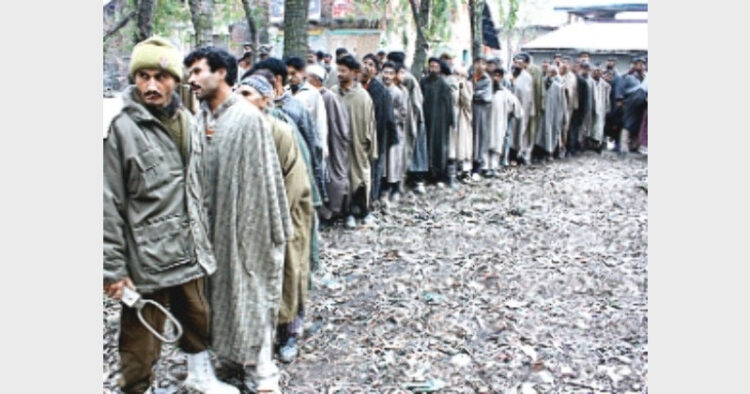Voting for Lok Sabha elections seemed like a festival in the villages of Jammu & Kashmir. Women, young boys and middle-aged men stood in long queues as they waited for their turn to vote. Angry at the government for ignoring their demands for long, the unprecedented 70 per cent voter turnout witnessed in Jammu-Kashmir parliamentary constituency has sent stress signals in the camps of the ruling alliance of National Conference (NC) and the Congress. The influence of the Narendra Modi was evident from the Modi badges that the voters standing in long queues bore, and from the BJP flags on their vehicles. Their mood perhaps typified the mood in the city of Jammu, where the anti-incumbency sentiment against the Congress was stronger than the sentiment against the local MP.
In this Lok Sabha (LS) election, voting has already been completed in three out of six parliamentary constituencies in five phases till now. The high voter turnout which is more than the state Assembly election is an answer to sections of media that had spread a lot of misinformation and misconceptions about the people of Jammu-Kashmir. In the state Assembly elections of 2008, a little more than the 60 per cent people had used their democratic right. Only 50 per cent people voted in parliamentary elections of 2009.
In this election, not all constituencies of the state have gone to election yet; but the voter turnout for both the seats of Jammu region was 71 per cent which is more than Bihar (55%), Uttar Pradesh (66%), Rajasthan (64%), Madhya Pradesh (64%) and Maharashtra (63%).
The current relation of India and Pakistan has direct influence on these voters. They believe that a strong and decisive leader at the centre can effectively deal with Pakistan and can cure their misery which they have been bearing for more than half century now.
From decades, people of the state have witnessed discriminatory and communal politics of the National Conference, and the Congress has been a silent supporter of such policies. Plethora of issues like Article 370, autonomy, self rule, discriminatory politics of Kashmir Valley centric set up, corruption, unemployment and terrorism have always been there, but this kind of voter turnout in Jammu-Kashmir is being considered historical. Issues remain to be addressed, but this time, the voters have high hopes of getting justice from the Modi sarkar. In the wake of election, it is also being reflected that if not yet, for sure after the results are declared on May 16, the Government of Jammu-Kashmir will regret its role in facilitating Kishtwar and alike riots.
Higher turnout from Jammu-Kashmir shows enthusiasm and connectedness of the people of the state for Delhi. With this two things become clear, Modi wave has an influence in Jammu region and that that the separatists have no base there. The increase of 20 per cent voting in LS elections is thus a direct indicator that people have voted for change this time. And they are hopeful to have a strong and decisive PM like Narendra Modi who can bring peace and promote development in their state.
If the sources are to be believed, Modi wave is going to wipe off Jammu and Ladakh regions completely. On May 16, people want to see change in Delhi and being a part of this wave that inspires change, the Jammu and Kashmir people have already stamped their support, and a similar voter turnout is expected from the other constituencies soon.
Three regions of Jammu-Kashmir have six parliamentary constituencies. Jammu and Udhampur constituencies fall under Jammu region. Anantnag, Srinagar and Baramulla (previously known as Varahmul) are parts of Kashmir region. Ladakh is the largest region and parliamentary constituency of Jammu-Kashmir. Out of these, Jammu has voted on April 10, Udhampur used its democratic rights to elect, on April 17 and Anantnag has voted on April 24. Of the remaining, Srinagar will vote on April 30 and Baramulla and Ladakh are going to have their index fingers marked on May 7.
-Arvind













Comments